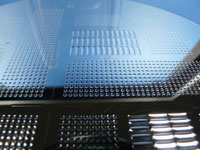
Glass Microlenses Support Miniaturization
Plan Optik AGRequest Info
• 5-mm to 50-μm diameters
• 0.02- to 0.32-numerical aperture
• <1-nm surface roughness
 Plan Optik AG offers planoconvex and planoconcave microlenses with a high packaging density in borosilicate glass, with diameters of 5 mm down to 50 μm.
Plan Optik AG offers planoconvex and planoconcave microlenses with a high packaging density in borosilicate glass, with diameters of 5 mm down to 50 μm.
The company says that, because of the continuous miniaturization of optical systems, the demand for micro-optical elements such as refractive microlenses is steadily increasing. Single microlenses as well as lens arrays are fabricated at wafer level in glass, and both planoconvex and planoconcave lenses with good reproducibility and homogeneity are possible. Microlenses in glass on the wafer level facilitate the cost-effective development and production of new optical microelectromechanical systems, data storage systems or other photonic applications. Well-known applications for lens arrays include laser beam shaping and homogenization, and the implementation of fibre couplers and Shack-Hartmann sensors.
The material is borosilicate glass with a refractive index of 1.474 at sodium D-line (Abbe number is 65.4). This glass is anodically bondable to silicon, enabling innovative assembly possibilities for optical systems, including the construction of lens systems at the wafer level. Borosilicate glass shows low fluorescence and transmission of more than 90% between 350 and 2500 nm. In contrast to plastics, glass allows mechanical, chemical and heat-sensitive applications, and it supports a long product lifetime.
Another advantage of the fabrication process is a smooth lens surface with average roughness of better than 1 nm. Lens specifications include diameters from 5 mm to 50 μm, sag of <0.6 mm, radius of curvature from 0.1 to 20 mm and focal length from 0.3 to 60 mm. Because of the wide range of lens diameters and lens sag, the numerical aperture can be between 0.02 and 0.32. The aberration of spherically shaped lenses is in the range of l/2 peak to valley. Besides circular apertures, the lens shape also can be rectangular for manufacturing cylindrical lenses.
https://www.planoptik.com
/Buyers_Guide/Plan_Optik_AG/c11901
Published: April 2008
REQUEST INFO ABOUT THIS PRODUCT
* First Name:
* Last Name:
* Email Address:
* Company:
* Country:
Message:
When you click "Send Request", we will record and send your personal contact information to Plan Optik AG by email so they may respond directly. You also agree that Photonics Media may contact you with information related to this inquiry, and that you have read and accept our
Privacy Policy and
Terms and Conditions of Use.
Register or login to auto-populate this form:
Login
Register
* Required